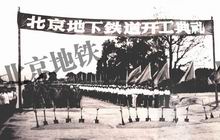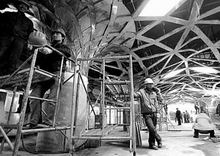The Beijing Subway was proposed in September 1953 by the city's planning committee and experts from the Soviet Union. Chinese leaders turned their attention to domestic reconstruction. They were keen to expand Beijing's mass transit capacity but also valued the subway as an asset for civil defense. They studied the use of the Moscow Metro to protect civilians, but the route of the initial line was shifted westward to create an underground conduit to move personnel from the heart of the capital to the Western Hills. On February 4, 1965, Chairman Mao Zedong personally approved the project.
|
|
| |
1965-1980 :
Construction began on July 1, 1965 at a ceremony attended by national leaders including Zhu De, Deng Xiaoping, and mayor Peng Zhen. The most controversial legacy of the initial subway line is the demolition of the Beijing's historic inner city wall to make way for the subway. Construction plans for the subway from Fuxingmen to the Beijing Railway Station called for the removal of the wall, as well as the gates and archery towers at Hepingmen, Qianmen, and Chongwenmen. Leading architect Liang Sicheng argued for protecting the wall as a landmark of the ancient capital. Chairman Mao favored demolishing the wall over demolishing homes. In the end, Premier Zhou Enlai managed to preserve Qianmen gate and its arrow tower by slightly altering the course of the subway. |
|
The initial line was completed in time to mark the 20th anniversary of the founding of the People's Republic on October 1, 1969. It ran 21 km from the army barracks at Fushouling to the Beijing Railway Station and had 16 stations. This line forms parts of present-day Lines 1 and 2. It was the first subway to be built in China, and predates the metros of Hong Kong, Seoul, Singapore, San Francisco and Washington D.C., but technical problems would plague the project for the next decade. |
 |
Chinese National Leaders |
|
| |
|
On November 11, 1969, an electrical fire killed 3 people, injured over 100 and destroyed two cars. Premier Zhou Enlai placed the subway under the control of the People¡¯s Liberation Army in 1970, but reliability problems persisted. On January 15, 1971, the initial line began operation on a trial basis between the Beijing Railway Station and Gongzhufen. Single ride fare was set at £¤0.10 and only members of the public with credential letters from their work units were permitted entry into the subway. The line delivered 8.28 million rides in 1971 but remained under trial operation throughout the Cultural Revolution. From 1971 to 1975, the subway was shut down for 398 days for political reasons. Despite its return to civilian control in 1976, the subway remained prone to closures due to fires, flooding, and accidents. |
| |
1981-2000:
On September 15, 1981, after a decade of trial operation, the initial line was finally opened to full public use. It had 19 stations and ran 27.6 km from Fushouling in the Western Hills to the Beijing Railway Station. Investment in the project totaled £¤706 million. The subway was placed under the management of Subway Company, then a subsidiary of the Beijing Public Transportation Company. Annual ridership reached 72.5 million in 1982. |
 |
Ceremony of Construction |
|
| |
|
On September 20, 1984, a second line was opened to the public. This horseshoe-shaped line was created from the eastern half of the initial line and corresponds to the southern half of the present-day Line 2. It ran 16.1 km from Fuxingmen to Jianguomen with 16 stations. Ridership reached 105 million in 1985. On December 28, 1987, the two existing lines were reconfigured into Lines 1, which ran from Pingguoyuan to Fuxingmen and Line 2, in its current loop, tracing the Ming city wall. Fares doubled to £¤0.20 for single-line rides and £¤0.30 for rides with transfers. Ridership reached 307 million in 1988. The subway was closed from June 3-4, 1989 during the suppression of the Tiananmen Square demonstrations. In 1990, the subway carried more than one million riders per day for the first time, as total ridership reached 381 million. After a fare hike to £¤0.50 in 1991, annual ridership declined slightly to 371 million. |
| |
|
On January 26, 1991, planning began on the eastward extension of Line 1 under Chang¡¯an Avenue from Fuxingmen with the receipt of 19.2 billion yen low-interest, development assistance loan from Japan. Construction began on the eastern extension on June 24, 1992. The Xidan station opened on December 12, 1992, and the remaining extension to Sihui East was completed on September 28, 1999. National leaders Wen Jiabao, Jia Qinglin, Yu Zhengsheng and mayor Liu Qi were on hand to mark the occasion. The full-length of Line 1 became operational on June 26, 2000, Despite little track expansion in the early 1990s, ridership grew rapidly to reach an all-time high of 558 million in 1995, but fell to 444 million the next year when fares rose from £¤0.50 to £¤2.00. After fares rose again to £¤3.00 in 2000, annual ridership fell to 434 million from 481 million in 1999. |
| |
|
2001-2008:
In the summer of 2001, the city won the bid to host the 2008 Summer Olympic Games and accelerated plans to expand the subway. From 2002 and 2008, the city planned to invest £¤63.8 billion (US$7.69 billion) in subway projects. Most new subway construction projects were funded by loans from the Big Four state banks. Line 4 is funded through a joint-venture with the Hong Kong MTR. To achieve plans for 19 lines and 561 km by 2015, the city will invest a total of £¤200 billion ($29.2 billion). |
 |
Olympic Projects |
|
| |
The next additions to the subway were surface commuter lines that linked to the north and east of the city. Line 13, a half loop that links the northern suburbs, first opened on the western half from Huilongguan to Xizhimen on September 28, 2002 and the entire line became operational on January 28, 2003. Batong Line, built as an extension to Line 1 to Tongzhou district, was opened as a separate line on December 27, 2003. Work on these two lines had begun respectively in December of 1999 and 2000. Ridership hit 607 million in 2004.
Line 5 came into operation on October 7, 2007. Construction had begun seven years earlier on September 25, 2000. It was the city's first north-south line, extending from the Songjiazhuang in the south to Tiantongyuan in the north. On the same day, subway fares were reduced from between £¤3 and £¤5 per ride, depending on the line and number of transfers, to a single flat fare of £¤2 with unlimited transfers. The lower fare policy caused the Beijing Subway to run a deficit of £¤600 million in 2007, which is expected to widen to £¤1 billion in 2008. The Beijing municipal government has covered these deficits to encourage mass transit use, which reduces traffic congestion and air pollution. On a total of 655 million rides delivered in 2007, the government's subsidy averages to be about £¤0.92 per ride.
On June 9, 2008, the use of paper tickets, hand checked by clerks for 38 years, was discontinued and replaced by electronic tickets that are scanned by automatic fare collection machines upon entry and exit of the subway. Stations are outfitted with touch screen vending machines that sell single-ride tickets and multiple-ride Yikatong fare cards.
On July 19, 2008, Line 10, the Olympic Branch Line, and the Airport Line were open for trial basis ahead of the Summer Olympic Games in August. With the addition of the three new lines, total ridership rose by 75% in 2008 to 1.2 billion.
After the Chinese government announced a major economic stimulus package in November 2008, Beijing urban planning commission further expedited subway building plans, especially for surface light rails to suburban districts that are cheaper to build. In December 2008, the commission moved up completion dates of the Yizhuang and Daxing Lines to 2010 from 2012, finalized the route of the Fangshan Line, and unveiled the Changping and Western Suburban Lines. |
|
Beijing-travels.com offers online information on Beijing Subway and More transportation of Beijing. Keep browsing our site for more information on China.
|
|
|